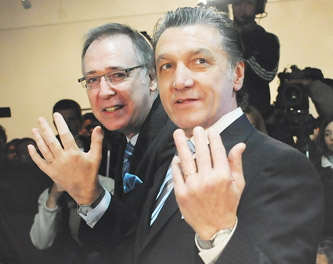Es el amor. Tendré que ocultarme o que huir.
Crecen los muros de su cárcel, como en un sueño atroz.
La hermosa máscara ha cambiado, pero como siempre es la única.
¿De qué me servirán los talismanes: el ejercicio de las letras, la vaga erudición,
el aprendizaje de las palabras que usó el áspero Norte
para cantar sus mares y sus espadas,
la serena amistad, las galerías de la Biblioteca,
las cosas comunes, los hábitos,
el joven amor de mi madre,
la sombra militar de mis muertos,
la noche intemporal, el sabor del sueño?
Estar contigo o no estar contigo, es la medida de mi tiempo.
Ya el cántaro se quiebra sobre la fuente, ya el hombre se levanta a la voz del ave,
ya se han oscurecido los que miran por la ventana, pero la sombra no ha traído paz.
Es, ya lo sé, el amor: la ansiedad y el alivio de oir tu voz, la espera y la memoria,
el horror de vivir en lo sucesivo.
Es el amor con sus mitologías, con sus pequeñas magias inútiles.
Hay una esquina por la que no me atrevo a pasar.
Ya los ejércitos me cercan, las hordas.
(Esta habitación es irreal; ella no la ha visto)
El nombre de una mujer me delata.
Me duele una mujer en todo el cuerpo.
Literal translation (fragment)
The threatened one
It's love. I'll have to hide or escape.
......................................................
Being with you or not being with you is the measure of my time.
The jar already breaks at the fountain,
man rises at the voice of birds,
those who look out of windows have already darkened,
but the shadows have brought no peace.
It's, I know, love:
the anxiety and the relief of hearing your voice,
the waiting and the memory, the horror of living from now on.
It's love with its mythologies,
its small useless spells.
There's a corner I don't dare go past.
Already the armies, the hordes surround me.
(This room is unreal; she hasn't seen it.)
The name of a woman betrays me.
A woman hurts in my whole body.




















